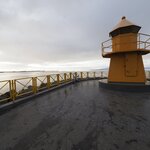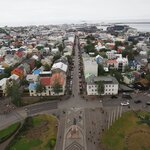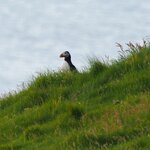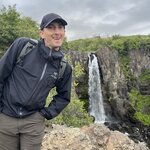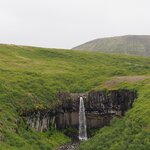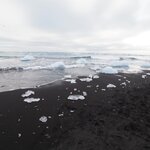Highlights
- Discover Þingvellir National Park and Gullfoss waterfall in the famed Golden Circle
- Tour stunning glacial areas of Skaftafell, Svartifoss, and Jökulsárlón Glacier Lagoon
- Spend a day hiking toward incredible views and visit puffins in the Westman Islands
- Enjoy relaxing, geothermal soaks in Secret Lagoon, Reykjadalur, and Blue Lagoon
Brief Itinerary
| Day | Highlights | Overnight |
|---|---|---|
| Day 1 | Arrival & Golden Circle Highlights | Golden Circle Area |
| Day 2 | South Coast Waterfalls & Black-Sand Beaches | Kirkjubæjarklaustur |
| Day 3 | Glaciers at Skaftafell, Svartifoss, & Jökulsárlón Lagoon | Kirkjubæjarklaustur |
| Day 4 | Ferry to Westman Islands for Hiking & Puffins | Westman Islands (Vestmannaeyjar) |
| Day 5 | Drive Back & Exploring Downtown Reykjavik | Reykjavik |
| Day 6 | Volcanic Reykjanes Peninsula, Blue Lagoon & Departure |
Detailed Itinerary
Day 1: Arrival & drive to Þingvellir, Geysir, & Gullfoss Falls in the Golden Circle

Welcome to Iceland! Arrive at Keflavík Airport (KEF) in the morning, and pick up your rental car. Stop in Reykjavík for breakfast, or just head straight out to explore the highlights of the Golden Circle, Iceland's most popular area.
Start with a tour of Þingvellir National Park, where the tectonic plates meet. Visit historical Law Rock, where chieftains from all over the country met once a year to discuss laws and issues, some traveling up to 17 days each way on foot or horseback. Þingvellir is also home to the Silfra Fissure, where you can join a snorkel or scuba tour, and dive between tectonic plates in crystal-clear water.
Next, visit the Geysir geothermal area, with bubbling mud pits and steam vents—the Strokkur geyser erupts like clockwork every 10 minutes—followed by a trip to Gullfoss (“Golden Falls”), a massive waterfall that is sure to impress.
Finish your day at Secret Lagoon in Flúðir. Enjoy a relaxing soak in the geothermal waters and a possible glimpse of the Northern Lights (from September-April, depending on the weather).
Day 2: Drive to the South Coast & explore waterfalls, black-sand beaches, & cliffs

After breakfast, hit the road and spend today enjoying the popular highlights of the south.
Your first stop is Seljalandsfoss waterfall, with access from behind just a few minutes from the parking lot. Note that the ground is uneven in a few places, and there are stairs on one side. Standing in a cave under the cliff, witness the water come roaring down 20-30 feet in front of you. Pay attention to the direction of the wind or wear a rain jacket (or both). When viewed from behind, spot two, smaller waterfalls to the right, as well.
Next, along Route 1, locate the powerful Skógafoss Waterfall. Skógafoss marks the beginning of the 16-mile Fimmvörðuháls Trail, which ends in Thórsmörk. Admire the waterfall from the bottom, just a 2-minute walk from the parking lot, or if you are up for it, find the stairs to the right and climb up for a different perspective. At the top, walk along the canyon for a bit to see more waterfalls along “Waterfall Way” before turning around.
Note: Depending on snow conditions, this may not be possible.
Then, make your way to the Dyrhólaey arch and cliffs. At Dyrhólaey, there are two parking lots where you can see the famous arch. (The one high on the hill offers the better view.) Take the bumpy, dirt road to your right as you enter. From the top, spot a lighthouse and great views looking further west, along a black-sand beach that reaches as far as you can see. Look for birds flying around; they nest along the cliffside.
As you near Vík, along Route 1, look for the turnoff to Reynisfjara Beach, past a pretty church, as you drive toward the water. This black-rock beach (not as fine-grain as the one in Vík) is most famous for the Reynisdrangar Columns—huge, hexagonal basalt columns rising up out of the sand. Walk 1-2 minutes around the cliffs to the left, as you face the ocean, to find a couple of large caves, as well.
Next, reach Vík. While the town itself is fairly small, its proximity to several great sights more than makes up for it. You can even explore the area in the evening, after the large crowds dissipate, or before the crowds arrive the next day. Toward the water, look for a black-sand beach with high cliffs on the right side, often filled with soaring and nesting birds.
Continue about 50 minutes further along Route 1 to the town of Kirkjubæjarklaustur. If you have more time, just a short drive away is Fjaðrárgljúfur Canyon, where the rock formations look like they’re from another world. There is a trail less than 1 mile from the parking lot, along the ridge of the canyon, that is home to some amazing viewpoints—where the river curves around these strange rock cliffs. Admire the views along the way, and venture as far as you like.
Chat with a local specialist who can help organize your trip.
Day 3: Discover Skaftafell, Svartifoss, & Jökulsárlón Glacier Lagoon

Today, explore Iceland's glaciers, ending at the Jökulsárlón Glacier Lagoon (which is just under 2 hours from Kirkjubæjarklaustur, or 3.5 hours roundtrip). You can also continue to Höfn, where there is a great visitor center on the glacier and nearby area, and several restaurants serving very fresh seafood—langoustine and lobster are the specialties.
Depending on your preference, and where you spend the night, consider the below stops along the way.
Visit Skaftafell, where you could spend many days hiking the trails all around. If short on time, the most popular hike leads to Svartifoss, a thin waterfall surrounded by columns of basalt. The 3-mile hike offers great views alongside the river and toward the ocean in the distance. For further exploration, feel free to join an ice cave tour, a glacier walk, or embark on an ice climbing excursion.
Next, a quick trip off the main road will bring you into Hof, where you can check out Hofskirkja, the turf church. The act of covering the roof with turf dates back to medieval times, and was practiced throughout Europe to offer protection from harsh weather.
Just a few minutes before Jökulsárlón Glacier, you will find another glacier lagoon about 10 minutes from the parking lot—Fjallsárlón Glacier Lagoon. Here, you are much closer to the glacier than at Jökulsárlón, and you’ll have better views of all the cracks and crevices.
Next, visit Jökulsárlón Glacier Lagoon, with the chance to witness one of the most unique sights in Iceland: icebergs floating out to sea, and beached on the black sand. Climb the hill for a better view of the entire area.
Follow the river under the bridge to the ocean, and find many smaller icebergs along the black, sandy shores of "Diamond Beach," where the waves crash, creating a memorable sight. You may be fortunate to see seals, porpoises, or small whales that sometimes hang out in the lagoon or near the shore.
Following the active day, relax and unwind on your own in Kirkjubæjarklaustur.
Day 4: Ferry to Westman Islands for hiking & highlights

Today, make an optional, 30-minute stop at Fjaðrárgljúfur Canyon (if you missed it on day two). Or, make your way directly to the beautiful Westman Islands—typically skipped by busy, roundtrip travelers, but a local favorite of many Icelanders.
Drive back along the South Coast, toward Seljalandsfoss waterfall, and turn off Route 1 near the Landeyjahöfn Ferry Terminal (just under 2 hours driving). Along the drive, you can stop at any of the sights you may have passed on your drive east.
Board a 30-minute ferry ride from Landeyjahöfn Harbor, and take advantage of a free afternoon on the island. The Vestmannaeyjar (another name for Westman Island) range in age from 50-40,000 years old. There are several ways to spend the afternoon.
You can embark on a guided tour of the island by minibus, or take a boat tour circling the island of Heimaey, the only inhabited island of the Vestmannaeyjar, to see the sea caves (a few of which you can enter), cliffs, birdlife (including thousands upon thousands of puffins in the summer, from mid-June to early-September), and possibly some whales.
There are fast, exhilarating RIB-boats (rigid-hulled inflatable boats) that circle the island, as well as slower, larger boats (for windy days), but the RIB-boats are likelier to run—and are the more adventurous (and highly recommended) option of the two.
Heimaey offers incredible views toward South Coast, including everything from volcanoes (there most recent eruption occurred in the 1970s) to glaciers. There is great hiking here, too, although the terrain is steep.
If you’re up for a scenic hike or two, consider the below excursions.
Walk up to the crater of Eldfell (“the Mountain of Fire"). Eldfell is a volcano that was formed in a volcanic eruption that began without any warning just outside the town of Heimaey on January 23, 1973. There is also a folk museum that tells the story of Tyrkjaránið, the so-called Turkish Abductions of 1627, considered to be the most horrific event in the nation‘s history.
Hike to the top of Herjólfsdalur, the location of the popular annual music festival Þjóðhátíð, which will challenge you, but it is worth it for the exceptional views over the islands.
Climb to the highest peak in Westman Islands, Heimaklettur, which requires using wooden ladders to get to the top—900 feet above sea level.
Places to eat and drink on the island include the below:
- Gott Restaurant
- SLIPPURINN
- The Brothers Brewery
Spend the night in the islands before heading back to the mainland tomorrow.
Day 5: Drive back from Westman Islands & self-guided tour of Reykjavík

Take the ferry to return to the mainland and head back to Reykjavík to spend the afternoon and evening exploring the fun capital city.
Along the way, budget for 3 hours to stop at the Reykjadalur hot spring river (just after Selfoss). Reykjadalur (“Smoky Valley") is home to an active, geothermal area and hot springs. Hike from the trailhead north to Reykjadalur for less than an hour before you arrive at a hot river coursing through the valley. The water temperature can vary by location, so find a spot that's right for you.
Following your soak, return Reykjavik for some self-exploration. Walk through compact downtown to check out the unique street art scene. Head to the water for the Sun Voyager Sculpture and the Harpa Concert Hall, with its unique, glass architecture. Visit Hallgrímskirkja, a church on the hill, and take the elevator to the top of the tower for a great view of the city below and panoramic views of the area.
If the need arises to escape inclement weather, consider visiting a few museums in town, such as the Northern Lights Center, Saga Museum, Marine Museum, or Whales of Iceland Exhibition. You can also join a whale watching tour from Reykjavík Harbour, and snack on a world-famous hot dog at Bæjarins Beztu Pylsur.
For delicious lunch and dinner recommendations, consider the below:
- Messinn
- Sea Barron
- Kol Restaurant
- The Coocoo's Nest
- Kaffivagninn (lunch only)
- Café Loki
If you are interested in checking out Reykjavík’s nightlife scene, visit the following bars:
- Craft Cocktails
- Mikkeller & Friends
- Skúli Craft Bar
- KEX Hostel Bar (live music on weekends)
Day 6: Visit the Reykjanes Peninsula & depart from Reykjavík

Spend your last day exploring more of Reykjavík. Stop by the Blue Lagoon on your drive to the airport, where you can enjoy one, last geothermal soak before you fly home.
If you have more time, visit some of the highlights around the Reykjanes Peninsula. The following places are often missed by travelers quickly traveling between Reykjavik and KEF airport for departure. With a bit more time, you can explore lava fields, geothermal areas, lighthouses, and small fishing towns.
These places are listed east to west, as you drive from Reykjavik to KEF clockwise around the peninsula:
- Krýsuvík geothermal area: While you can walk around the area near the parking lot in as little as 5 minutes, take your time to see the steam vents and hot pools up close. Look up at the multicolored hills surrounding the area. There’s a short, steep trail up the hill, which offers great views on a clear day.
- Gunnuhver hot springs and geothermal area: Here, find a couple of bubbling and steaming mud pools. Gunnuhver is named after a female ghost who was said to be trapped in the hot springs more than 400 years ago. Temperatures are extremely hot, so stick to the walkways and viewing areas. While here, continue about 5 minutes to the cliffs to stop at Reykjanesviti lighthouse with beautiful views of Iceland from atop a hill.
- Bridge Between Continents (Europe Miðlína): This area is a great symbol of Icelandic geology. The Reykjanes Peninsula is on the Mid-Atlantic Ridge, which pulls apart a few centimeters every year. You can cross the bridge between the continental plates while you’re here, and look down at the gap below.
- Garður Lighthouse: About 15 minutes north of KEF, you will arrive at two lighthouses—one on the coast (older and not as stable), and a second a bit further inland. This scenic area can be a nice area to walk around and stretch your legs before boarding your return flight home.



